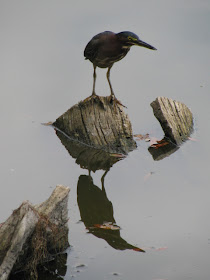
There are many things distinctive about the Cormorant. Its bill, blunted or hooked at the tip, helps separate it from the somewhat similar Anhinga. This Cormorant is called Double-crested for the feathered tufts on its head, which are not easy to spot.
The Cormorant has webbed feet and is quite a swimmer. It can stay underwater and catch fish and other marine critters.

The name ‘Cormorant’ has been derived from the Latin words ‘Corvus Marinus’, which means ‘marine crow’ or ‘sea raven’. Cormorants are also known as shags in some parts of the world.

Cormorants are fun to watch especially when drying themselves after a swim. And they don't seem as skiddish toward humans as other big birds I've encountered.
Awkwardly regal-- that's the Double-crested Cormorant. Armed with its own can opener beak to crack crustaceans and mollusks.

Unusual eyes too on the Cormorants! Took these photos at Charleston's Magnolia Cemetery in October 2010. By the way, a flock of Cormorants is called a "gulp." Another odd fact about this odd bird.




























